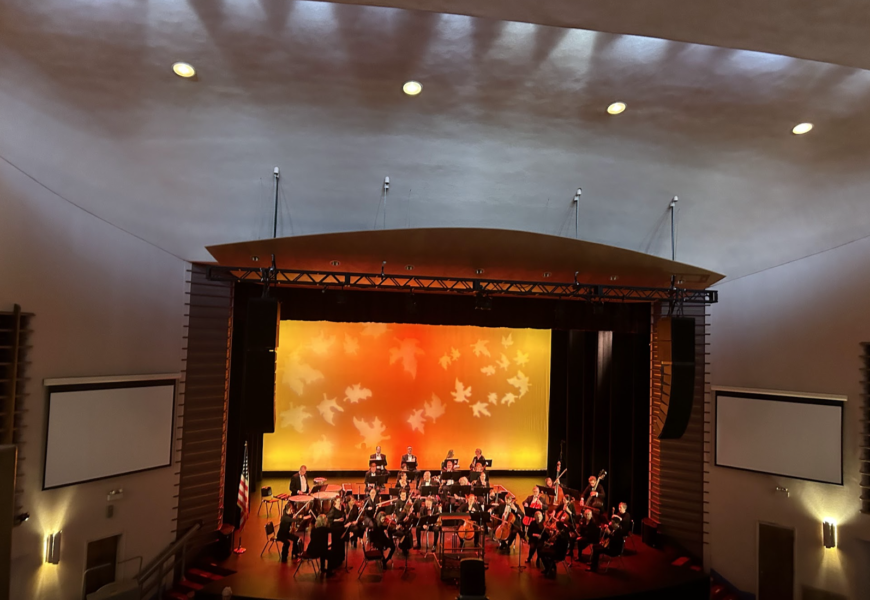Image Courtesy of Emma Dinkelspiel
Inaccessible. Outdated. Pretentious. Is there even a space for classical music in our contemporary world? On November 11, the Greater Bridgeport Symphony (GBS) undoubtedly made a home for the classics in Connecticut while simultaneously disproving these negative stereotypes about the genre. The concert, entitled Mingling with Mozart, bridged the divide between past and present through an innovative program featuring some of Mozart’s most renowned pieces along with Flo Menezes’s “Mozart Trans-criations.”
GBS hosts their concerts at the beautiful Klein Memorial Auditorium in Bridgeport, Connecticut. This historical theater boasts excellent acoustics and space for over 1400 audience members. For the November show, orange and yellow fall leaves were projected behind the orchestra which casted an autumnal glow onto the musicians.
Mingling with Mozart was the second of five concerts in GBS’s 2023-2024 season, each of which strives to build and cultivate relationships with the local community. Because this concert coincided with Veteran’s Day, the program began with a rendition of “The Star Spangled Banner.” Members of the audience sang along with the ensemble’s operatic soloists in order to honor veterans both in the building and in the greater community.
“GBS is an important cultural and educational instrument that exists to support this community’s effort to bring not only music and entertainment to its audiences, but also to ensure that future audiences have access to and enjoy orchestral music,” said conductor, Eduardo Leandro. Because of this, the first concert this season not only featured a very modern 20th century program, but it also highlighted multiple music students from the local area, including one 10-year-old percussionist. For Mingling with Mozart, the ensemble asked audience members to donate canned food and nonperishable items prior to the show in order to support the Bridgeport Rescue Mission which provides both pantry items and hot meals to local families.
The true program began with Mozart’s Overture to “The Marriage of Figaro.” This piece requires extreme precision within the string section, particularly with the carefully articulated bowing at the beginning. Despite this challenge, the orchestra truly sounded like one instrument working to create a beautiful mosaic of textures. The winds and brass brought volume and energy which gave life to the melody.
Next, the two soloists came to the stage to perform excerpts from some of Mozart’s most notable operas: Figaro, Don Giovanni, Così fan tutte, and The Magic Flute. Soprano, Jessica Rizzio, and baritone, Thomas Woodman, not only sang their solos, but also performed them. Despite the small space they had to perform, they provided a semi-staged rendition of their excerpts. This was successful in increasing accessibility to the music. One of the common problems with opera for audience members is that its language and tone can stifle the plot and increase confusion. This was not true for Mingling with Mozart. Audience members laughed alongside performers when Leandro himself temporarily abandoned his role as conductor to sing an excerpt from Figaro.
On the excerpts, Leandro said, “The idea is to show the influence that opera had in his orchestral, and vice-versa, so that an aria or duet almost sounds like a symphonic movement, and his symphony sounds as alive as opera.” The theme of building bridges between genre, time, and communities was essential to the performance, but Leandro also made a concerted effort to build bridges between audience and performer, musician and soloist, and conductor and artist.
Another highlight of the opera excerpts came in the last duet of The Magic Flute. Rizzio and Woodman entered the stage in comical costumes: Rizzio with a large feather boa and Woodman with a tophat adorned with colorful feathers. They performed this final, hilarious movement in English as opposed to in its original German which allowed for the audience to pick up on the comical dialogue between the two soloists.
Following a brief intermission, a smaller orchestra returned to the stage to perform “Mozart Trans-Criations” by Flo Menezes. Composed in 1986, this 8-minute piece brought Mozart into the modern world. Beginning with a simple melody that Mozart originally composed on the keyboard, the piece became increasingly augmented as canons shifted keys and styles. Slow glissandos played beneath jarring harmonics to create a hauntingly beautiful atmosphere. “I didn’t know I was at a jazz concert,” I heard a man behind me joke at the end of the piece.
The concert concluded with Mozart’s Symphony No. 41 in C Major (“Jupiter”). This was one of the last symphonies Mozart ever wrote, and it helped to bring the concert to a happy conclusion. “Jupiter” exists as a culmination of Mozart’s works which gave inspiration to countless classical composers since. Thus, it serves as another kind of bridge between past and present. The highlight of the symphony was the second movement “Andante cantabile (F major)” which featured muted violins and melancholic melodies. The layers of instrumentation created an ethereal sound.
One of the most common taboos in classical music is that people are not supposed to clap between symphonic movements. Often any sound between movements is considered disrespectful and might result in harsh glares from fellow audience members. There was none of this pretension at Mingling with Mozart. When audience members were moved by the music, they conveyed it with applause even if it was between movements. Just as Leandro announced before “Jupiter,” “This is still your orchestra, so use it as such.”
The symphony will be performing their last show of 2023 on December 16. The program, entitled Uniting at Yuletide, will feature popular holiday music as well as singalongs and classical selections.











So excited to read this exceptional piece on the Greater Bridgeport Symphony written by Emma Dinkelspiel. A thoughtful and knowledgeable connoisseur of great music indeed! :)